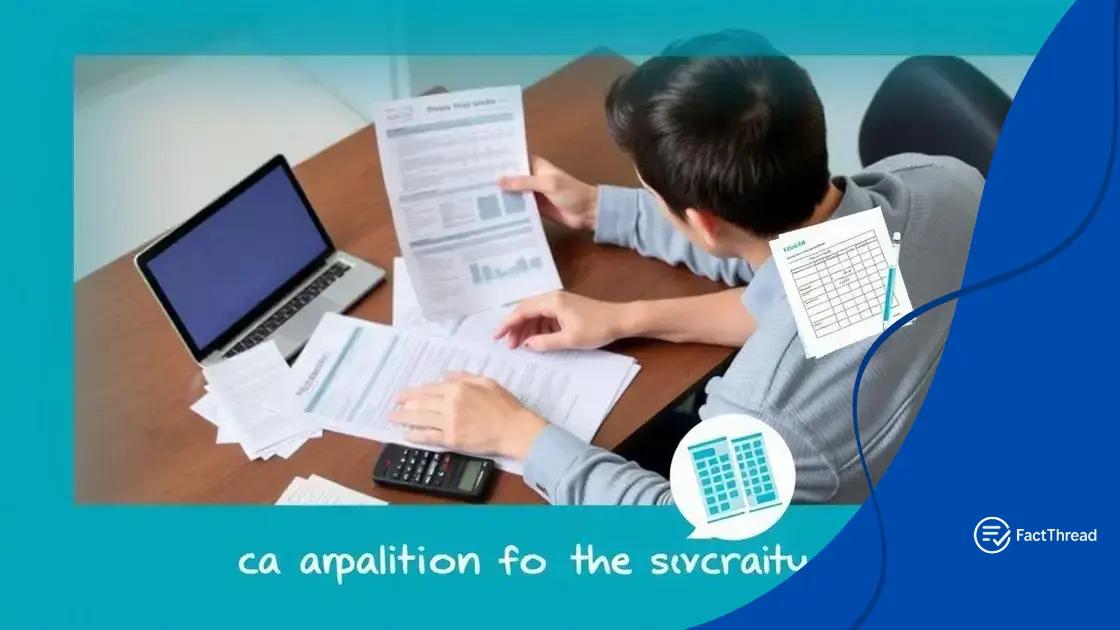Tax credit awareness for low-income families: crucial facts

Tax credit awareness for low-income families is essential as it provides financial relief, helping eligible households to reduce their tax liability and access refunds through various available credits.
Tax credit awareness for low-income families can make a significant difference in their financial stability. Have you ever wondered how these credits provide relief? Let’s dive in!
Understanding the benefits of tax credits
Understanding the benefits of tax credits is vital for low-income families. Tax credits can reduce the amount of income tax you owe, and in some cases, provide a refund.
These credits are designed to alleviate financial strains and enhance household income. Families can use this additional money for essential expenses like food, housing, and healthcare. Overall, tax credits aim to improve the quality of life by providing vital financial support.
Types of tax credits
There are various kinds of tax credits available. Some of the most common ones include:
- Earned Income Tax Credit (EITC): A credit for working individuals with low to moderate income.
- Child Tax Credit: Designed to help families with children by reducing their tax liability.
- American Opportunity Tax Credit: Helps families pay for post-secondary education.
- Lifetime Learning Credit: Available for those pursuing education beyond high school.
Each credit has its own eligibility requirements and benefits. It’s essential to understand these differences to maximize your tax benefits. Knowing which credits you qualify for can make a significant difference in your financial situation.
Applying for these credits can sometimes be complicated, but resources are available to assist you. Local tax preparation services and online tools can simplify the application process.
Impact on financial stability
The impact of tax credits on a family’s financial stability can be profound. Families receiving these credits often experience reduced stress related to finances. With tax credits, many families report being able to cover unexpected expenses or save for future needs.
Moreover, these benefits can lead to improved access to necessities and a better quality of life. Understanding how to claim these credits is crucial for maximizing your benefits.
Types of tax credits available for low-income families
Understanding the different types of tax credits available for low-income families is essential for making the most of available benefits. These credits can play a significant role in reducing tax liabilities and providing financial relief.
Families should familiarize themselves with these options to maximize their financial benefits. Various tax credits cater specifically to low-income families, each designed to address unique needs.
Earned Income Tax Credit (EITC)
The Earned Income Tax Credit (EITC) is one of the most beneficial programs. It provides a refund to low-to-moderate income working individuals and families. The amount varies based on income and the number of children in the household.
Child Tax Credit
Another important option is the Child Tax Credit. Parents can claim this credit for each qualifying child, which can significantly reduce their tax burden. Depending on income, families may receive a considerable amount per child.
- For 2023, the maximum credit per child is $2,000.
- Families with income below a certain threshold can benefit from the full amount.
- This credit can also be partially refundable, meaning families may receive money back.
American Opportunity Tax Credit
The American Opportunity Tax Credit is aimed at helping families afford higher education expenses. This credit is available for the first four years of post-secondary education. Eligible students can claim up to $2,500 per student for qualified education expenses.
Lifetime Learning Credit
Similarly, the Lifetime Learning Credit can provide up to $2,000 per tax return for qualified tuition and related expenses for higher education. Unlike the American Opportunity Tax Credit, this credit is available for an unlimited number of years.
Being aware of these tax credits can help low-income families access funds that significantly improve their financial situations. It’s crucial to seek guidance on how to apply for these credits effectively.
How to apply for tax credits effectively

Knowing how to apply for tax credits effectively is essential for maximizing your financial benefits. The process can seem daunting, but it is straightforward with the right information.
Start by gathering all necessary documents. This typically includes your income statements, identification numbers, and any relevant tax forms from the previous year. Proper documentation makes the application process smoother and helps avoid delays.
Understanding eligibility
Before applying, it is crucial to understand the eligibility criteria for each tax credit. Check the requirements for credits you plan to claim. This typically includes:
- Income limits based on your family size.
- Filing status, whether single, married, or head of household.
- Specific conditions related to dependents.
Each credit has distinct qualifications that must be met. Take your time to review them carefully.
Using tax software or professional help
Utilizing tax software can streamline the application process. Many programs guide you through the required steps and help determine which credits you qualify for. If you are uncertain, seeking help from a tax professional can provide clarity and ensure accurate filing.
Remember, local resources are also available. Community organizations often provide free assistance with tax preparation, particularly for low-income families. Look for annual tax events in your area that offer these services.
Filing your tax return on time is equally important. Make sure you meet the deadlines to avoid penalties. Most tax credits require you to file your return, so ensure all forms are submitted before the due date.
Lastly, keep copies of your documents and filings. This helps track your application and is useful for future reference.
Common myths about tax credits
There are several common myths about tax credits that can mislead low-income families. Understanding the truth behind these myths is vital for making informed financial decisions.
One of the biggest misconceptions is that tax credits are only for the wealthy. In reality, many tax credits specifically target low-income families to help them reduce their tax burden and improve their financial situations. It’s essential to recognize that these benefits are designed to provide support, not just for those with high incomes.
Myth: You must owe taxes to benefit from tax credits
Another myth is that you must have a tax liability to receive any benefits. In fact, many credits are refundable, meaning families may receive money back even if they do not owe taxes. For example, the Earned Income Tax Credit (EITC) is a refundable credit that can result in a refund, providing crucial financial support.
Myth: Tax credits are complicated and not worth the effort
Some believe that applying for tax credits is too complex and not worth the effort. While the process can seem challenging, many resources are available to assist. Tax software and community organizations offer help, ensuring that families can easily navigate the application process and claim their eligible benefits.
- Local non-profits often provide free tax preparation services.
- Online tools can guide you step-by-step in applying for credits.
- Many credits have simplified requirements that are easy to meet.
Additionally, the potential financial benefits far outweigh the effort required. Each credit claimed can provide substantial financial relief.
Myth: All tax credits are the same
Another misconception is that all tax credits offer the same benefits. In reality, tax credits vary widely, each designed to support different needs. Examples include the Child Tax Credit, which benefits families with children, and the American Opportunity Tax Credit, aimed at higher education costs.
Understanding the differences in these credits is crucial for maximizing the benefits available. Families should educate themselves on which credits align with their specific situations and goals.
Resources for low-income families seeking assistance
Finding resources for low-income families seeking assistance is crucial for improving financial stability. Various programs and organizations are dedicated to helping families navigate their challenges.
One of the most accessible resources is local community assistance programs. These programs often offer food pantries, clothing banks, and emergency financial aid. Many nonprofits focus on improving the quality of life for families struggling with low incomes.
Government assistance programs
Several government programs provide essential support. These include:
- Supplemental Nutrition Assistance Program (SNAP): This program helps families afford nutritious food.
- Temporary Assistance for Needy Families (TANF): TANF provides temporary financial assistance to low-income families with children.
- Medicaid: A health coverage program for eligible low-income individuals and families.
Applying for these programs is often straightforward. Families should check their eligibility and collect the necessary documents to begin the process.
Nonprofit organizations
Many nonprofit organizations also offer valuable resources. These groups often provide counseling, job training, and educational workshops. They aim to empower families by providing skills and knowledge to improve their circumstances.
Some key organizations to consider include:
- United Way, which connects families to local resources.
- Feeding America, a nationwide network of food banks.
- Neighborhood Housing Services, offering homeownership support.
Connecting with local nonprofits can provide additional resources and community support.
Additionally, many school districts offer support services for low-income families, including free or reduced-price meals for children and after-school programs. Families should reach out to their child’s school to learn about available resources.
In summary, understanding tax credits can significantly improve the financial well-being of low-income families. It is essential to know the types of credits available and how to apply for them effectively. Clearing up common myths about tax credits can empower families to utilize these benefits to their advantage. Finally, numerous resources are available to assist those in need, providing support for education, nutrition, and financial stability. Families should take the time to explore these opportunities to enhance their quality of life and secure a brighter future.
FAQ – Frequently Asked Questions about Tax Credits for Low-Income Families
What are tax credits and how do they help low-income families?
Tax credits reduce the amount of tax a family owes and can provide a refund, making them crucial for improving financial stability.
Do I need to owe taxes to benefit from refundable tax credits?
No, refundable tax credits can provide a refund even if you don’t owe any taxes. This means you can receive money back.
Where can I find resources and assistance for applying for tax credits?
Local community organizations, nonprofits, and government programs offer resources and assistance for families looking to apply for tax credits.
What are some common myths about tax credits?
Common myths include the belief that tax credits are only for the wealthy or too complicated to apply for. In reality, they are designed to assist low-income families.